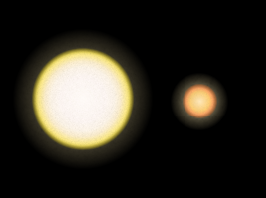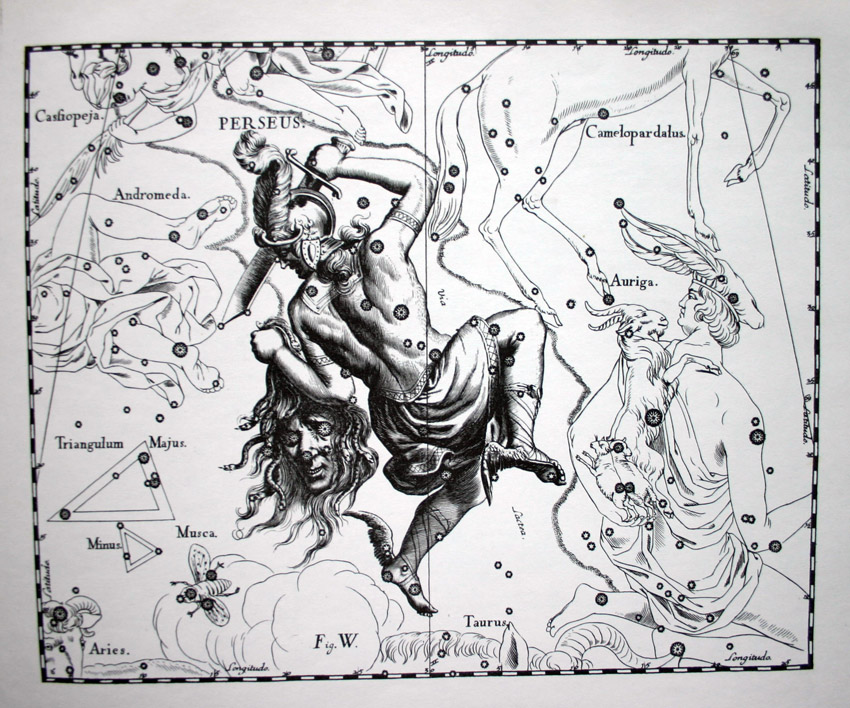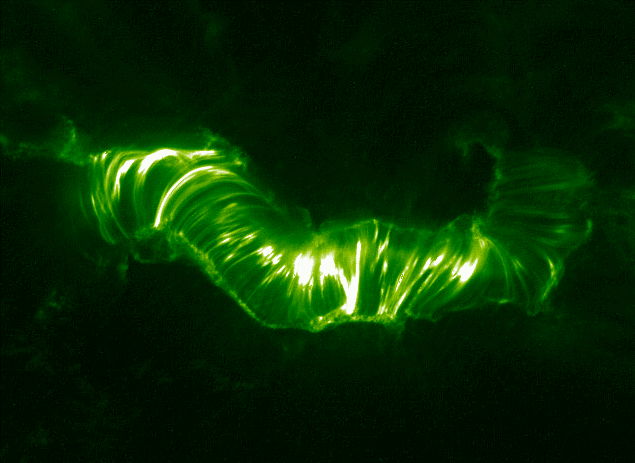|
Gliese 581 Planetary System
Gliese 581 () is a red dwarf star of spectral type M3V at the center of the Gliese 581 planetary system, about 20 light years away from Earth in the Libra constellation. Its estimated mass is about a third of that of the Sun, and it is the 89th closest known star to the Sun. Gliese 581 is one of the oldest, least active M dwarfs known. Its low stellar activity improves the likelihood of its planets retaining significant atmospheres, and lessens the sterilizing impact of stellar flares. History of observations Gliese 581 is known at least from 1886, when it was included in Eduard Schönfeld's ''Southern (SD)''—the fourth part of the '. The corresponding designation is BD -7 4003. Characteristics The name ''Gliese 581'' refers to the catalog number from the 1957 survey '' Gliese Catalogue of Nearby Stars'' of 965 stars located within 20 parsecs of the Earth. Other names of this star include ''BD-07° 4003'' ( BD catalogue, first known publication) and ''HO Librae'' (v ... [...More Info...] [...Related Items...] OR: [Wikipedia] [Google] [Baidu] |
Libra (constellation)
Libra is a constellation of the zodiac and is located in the Southern celestial hemisphere. Its name is Latin for weighing scales. Its old astronomical symbol is (♎︎). It is fairly faint, with no first magnitude stars, and lies between Virgo to the west and Scorpius to the east. Beta Librae, also known as Zubeneschamali, is the brightest star in the constellation. Three star systems are known to have planets. Features Stars Overall, there are 83 stars within the constellation's borders brighter than or equal to apparent magnitude 6.5. The brightest stars in Libra form a quadrangle that distinguishes it for the unaided observer. Traditionally, Alpha and Beta Librae are considered to represent the scales' balance beam, while Gamma and Sigma are the weighing pans. Alpha Librae, called Zubenelgenubi, is a multiple star system divisible into two stars when seen through binoculars, The primary (Alpha2 Librae) is a blue-white star of magnitude 2.7 and the secondary (Alpha ... [...More Info...] [...Related Items...] OR: [Wikipedia] [Google] [Baidu] |
Luyten Proper-Motion Catalogue
A star catalogue is an astronomical catalogue that lists stars. In astronomy, many stars are referred to simply by catalogue numbers. There are a great many different star catalogues which have been produced for different purposes over the years, and this article covers only some of the more frequently quoted ones. Star catalogues were compiled by many different ancient people, including the Babylonians, Greeks, Chinese, Persians, and Arabs. They were sometimes accompanied by a star chart for illustration. Most modern catalogues are available in electronic format and can be freely downloaded from space agencies' data centres. The largest is being compiled from the spacecraft Gaia and thus far has over a billion stars. Completeness and accuracy are described by the faintest limiting magnitude V (largest number) and the accuracy of the positions. Historical catalogues Ancient Near East From their existing records, it is known that the ancient Egyptians recorded the names of on ... [...More Info...] [...Related Items...] OR: [Wikipedia] [Google] [Baidu] |
Bonner Durchmusterung
In astronomy, Durchmusterung or Bonner Durchmusterung (BD) is an astrometric star catalogue of the whole sky, compiled by the Bonn Observatory in Germany from 1859 to 1903. The name comes from ('run-through examination'), a German word used for a systematic survey of objects or data. The term has sometimes been used for other astronomical surveys, including not only stars, but also the search for other celestial objects. Special tasks include celestial scanning in electromagnetic wavelengths shorter or longer than visible light waves. Original catalog The 44 years of work on the Bonner Durchmusterung (abbreviated BD), initiated by Friedrich Argelander and largely carried out by his assistants, resulted in a catalogue of the positions and apparent magnitudes of approximately 325,000 stars to apparent magnitude 9–10. The catalogue was accompanied by charts plotting the positions of the stars, and was the basis for the ''Astronomische Gesellschaft Katalog'' (AGK) and '' Smith ... [...More Info...] [...Related Items...] OR: [Wikipedia] [Google] [Baidu] |
Eduard Schönfeld
Eduard Schönfeld (22 December 18281 May 1891) was a German astronomer. Education Schönfeld was born at Hildburghausen, in the Duchy of Saxe-Meiningen, where he had a distinguished career at the gymnasium. On leaving the gymnasium, he desired to devote himself to astronomy, but abandoned the idea in deference to his father's wishes. He went first to Hanover, and afterwards to Kassel to study architecture, for which he seems to have had little inclination. 1849 found him studying chemistry under Bunsen at Marburg, where his love for astronomy was revived by Gerling's lectures. In 1851 he visited the Bonn Observatory and studied astronomy under Friedrich Wilhelm Argelander. In 1853 he was appointed assistant, and in the following year won a doctor's degree with his treatise ''Nova elementa Thetidis''. At Bonn he took an important part in preparing the ''Durchmusterung'' of the northern heavens. He took up the investigation of the light-changes in variable star A variable st ... [...More Info...] [...Related Items...] OR: [Wikipedia] [Google] [Baidu] |
Solar Flare
A solar flare is an intense localized eruption of electromagnetic radiation in the Sun's atmosphere. Flares occur in active regions and are often, but not always, accompanied by coronal mass ejections, solar particle events, and other solar phenomena. The occurrence of solar flares varies with the 11-year solar cycle. Solar flares are thought to occur when stored magnetic energy in the Sun's atmosphere accelerates charged particles in the surrounding plasma. This results in the emission of electromagnetic radiation across the electromagnetic spectrum. High-energy electromagnetic radiation from solar flares is absorbed by the daylight side of Earth's upper atmosphere, in particular the ionosphere, and does not reach the surface. This absorption can temporarily increase the ionization of the ionosphere which may interfere with short-wave radio communication. The prediction of solar flares is an active area of research. Flares also occur on other stars, where the term ... [...More Info...] [...Related Items...] OR: [Wikipedia] [Google] [Baidu] |
Atmosphere
An atmosphere () is a layer of gas or layers of gases that envelop a planet, and is held in place by the gravity of the planetary body. A planet retains an atmosphere when the gravity is great and the temperature of the atmosphere is low. A stellar atmosphere is the outer region of a star, which includes the layers above the opaque photosphere; stars of low temperature might have outer atmospheres containing compound molecules. The atmosphere of Earth is composed of nitrogen (78%), oxygen (21%), argon (0.9%), carbon dioxide (0.04%) and trace gases. Most organisms use oxygen for respiration; lightning and bacteria perform nitrogen fixation to produce ammonia that is used to make nucleotides and amino acids; plants, algae, and cyanobacteria use carbon dioxide for photosynthesis. The layered composition of the atmosphere minimises the harmful effects of sunlight, ultraviolet radiation, the solar wind, and cosmic rays to protect organisms from genetic damage. The ... [...More Info...] [...Related Items...] OR: [Wikipedia] [Google] [Baidu] |
Libra Constellation
Libra is a constellation of the zodiac and is located in the Southern celestial hemisphere. Its name is Latin for weighing scales. Its old astronomical symbol is (♎︎). It is fairly faint, with no first magnitude stars, and lies between Virgo to the west and Scorpius to the east. Beta Librae, also known as Zubeneschamali, is the brightest star in the constellation. Three star systems are known to have planets. Features Stars Overall, there are 83 stars within the constellation's borders brighter than or equal to apparent magnitude 6.5. The brightest stars in Libra form a quadrangle that distinguishes it for the unaided observer. Traditionally, Alpha and Beta Librae are considered to represent the scales' balance beam, while Gamma and Sigma are the weighing pans. Alpha Librae, called Zubenelgenubi, is a multiple star system divisible into two stars when seen through binoculars, The primary (Alpha2 Librae) is a blue-white star of magnitude 2.7 and the secondary (Alpha ... [...More Info...] [...Related Items...] OR: [Wikipedia] [Google] [Baidu] |
Earth
Earth is the third planet from the Sun and the only astronomical object known to harbor life. While large volumes of water can be found throughout the Solar System, only Earth sustains liquid surface water. About 71% of Earth's surface is made up of the ocean, dwarfing Earth's polar ice, lakes, and rivers. The remaining 29% of Earth's surface is land, consisting of continents and islands. Earth's surface layer is formed of several slowly moving tectonic plates, which interact to produce mountain ranges, volcanoes, and earthquakes. Earth's liquid outer core generates the magnetic field that shapes the magnetosphere of the Earth, deflecting destructive solar winds. The atmosphere of the Earth consists mostly of nitrogen and oxygen. Greenhouse gases in the atmosphere like carbon dioxide (CO2) trap a part of the energy from the Sun close to the surface. Water vapor is widely present in the atmosphere and forms clouds that cover most of the planet. More sola ... [...More Info...] [...Related Items...] OR: [Wikipedia] [Google] [Baidu] |
Light-years
A light-year, alternatively spelled light year, is a large unit of length used to express astronomical distances and is equivalent to about 9.46 trillion kilometers (), or 5.88 trillion miles ().One trillion here is taken to be 1012 (one million million, or billion in long scale). As defined by the International Astronomical Union (IAU), a light-year is the distance that light travels in a vacuum in one Julian year (365.25 days). Because it includes the time-measurement word "year", the term ''light-year'' is sometimes misinterpreted as a unit of time. The ''light-year'' is most often used when expressing distances to stars and other distances on a galactic scale, especially in non-specialist contexts and popular science publications. The unit most commonly used in professional astronomy is the parsec (symbol: pc, about 3.26 light-years) which derives from astrometry; it is the distance at which one astronomical unit subtends an angle of one second of arc. ... [...More Info...] [...Related Items...] OR: [Wikipedia] [Google] [Baidu] |
Stellar Classification
In astronomy, stellar classification is the classification of stars based on their spectral characteristics. Electromagnetic radiation from the star is analyzed by splitting it with a prism or diffraction grating into a spectrum exhibiting the rainbow of colors interspersed with spectral lines. Each line indicates a particular chemical element or molecule, with the line strength indicating the abundance of that element. The strengths of the different spectral lines vary mainly due to the temperature of the photosphere, although in some cases there are true abundance differences. The ''spectral class'' of a star is a short code primarily summarizing the ionization state, giving an objective measure of the photosphere's temperature. Most stars are currently classified under the Morgan–Keenan (MK) system using the letters ''O'', ''B'', ''A'', ''F'', ''G'', ''K'', and ''M'', a sequence from the hottest (''O'' type) to the coolest (''M'' type). Each letter class is then subdivi ... [...More Info...] [...Related Items...] OR: [Wikipedia] [Google] [Baidu] |
Red Dwarf
''Red Dwarf'' is a British science fiction comedy franchise created by Rob Grant and Doug Naylor, which primarily consists of a television sitcom that aired on BBC Two between 1988 and 1999, and on Dave (TV channel), Dave since 2009, gaining a cult following. The series follows low-ranking technician Dave Lister, who awakens after being in suspended animation for three million years to find that he is the last living human, and that he is alone on the mining spacecraft ''Red Dwarf''—save for a hologram his deceased bunkmate Arnold Rimmer and "Cat (Red Dwarf), Cat", a life form which evolved from Lister's pregnant cat. As of 2020, the cast includes Chris Barrie as Rimmer, Craig Charles as Lister, Danny John-Jules as Cat (Red Dwarf), Cat, Robert Llewellyn as the sanitation droid Kryten, and Norman Lovett as the ship's computer, Holly (Red Dwarf), Holly. To date, twelve series of the show have aired, (including one miniseries), in addition to a Television film, feature-length s ... [...More Info...] [...Related Items...] OR: [Wikipedia] [Google] [Baidu] |
Centre De Données Astronomiques De Strasbourg
Center or centre may refer to: Mathematics *Center (geometry), the middle of an object * Center (algebra), used in various contexts ** Center (group theory) ** Center (ring theory) * Graph center, the set of all vertices of minimum eccentricity Places United States * Centre, Alabama * Center, Colorado * Center, Georgia * Center, Indiana * Center, Jay County, Indiana * Center, Warrick County, Indiana * Center, Kentucky * Center, Missouri * Center, Nebraska * Center, North Dakota * Centre County, Pennsylvania * Center, Portland, Oregon * Center, Texas * Center, Washington * Center, Outagamie County, Wisconsin * Center, Rock County, Wisconsin **Center (community), Wisconsin *Center Township (other) *Centre Township (other) *Centre Avenue (other) *Center Hill (other) Other countries * Centre region, Hainaut, Belgium * Centre Region, Burkina Faso * Centre Region (Cameroon) * Centre-Val de Loire, formerly Centre, France * Centre (de ... [...More Info...] [...Related Items...] OR: [Wikipedia] [Google] [Baidu] |





